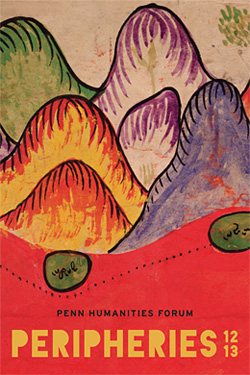Topic Director: Kevin M.F. Platt
Edmund J. and Louise W. Kahn Term Professor in the Humanities and Chair, Program in Comparative Literature and Literary Theory
The term “periphery” is derived from the Greek περιφέρω—to move around a circumference. It’s a spatial concept, yet one ripe for metaphorical extension. The world is broken into centers and peripheries that index degrees of significance, create and reflect distributions of power, and articulate standards and deviations. To explore peripheries, therefore, is to raise questions not only about geography but also about hierarchy, power, and social norms.
Peripheries and centers repeat, like fractals, on every level and scale. Whether we think historically, about the unequal distribution of power and resources between imperial metropoles and their far flung dominions, or in a contemporary frame, about the complex economic ties that enable world financial hubs like Singapore and New York to dominate outposts in Equador or Mongolia, the organization of global space into centers and peripheries is a defining framework. Yet economic and military hegemons like the US and China include their own centers—New York, Beijing—and peripheries—Laramie, Kaxgar—which are themselves variegated on a finer scale into centers and outlying regions. The built environments we inhabit—neighborhoods, university campuses, homes, and office buildings—have their official or intended centers and peripheries, which may or may not correspond to the actual zones of human congregation and dispersion within them. Society in general is structured according to logics of proximity and exclusion that resemble these spatial arrangements but do not perfectly coincide with them. Our very bodies are understood biologically to comprise cores and extremities, central and peripheral nervous systems. Even our psychic lives involve a kind of affective mapping, such that issues of seemingly remote significance may figure at the center of our felt concerns, while matters of more obvious worldly consequence are consigned to the emotive periphery.
Peripheries are often border zones where peoples or things are thrown into unexpected contact, hybrid spaces yielding new possibilities for social and cultural organization. Think of the musical genres, poetic innovations, and linguistic creoles of the Caribbean; or think of the social “margins” or the “queer periphery,” where disenfranchisement and stigmatization give rise to relatively free experimentation in social practices and cultural life. Though centers may seem more advanced or more privileged than peripheries, decisive change and innovation often begin at the fringes. Yet the very tendency toward difference and transformation out on the margins often meets with a violent reimposition of norms from the center: Soviet tanks rolling into Prague, or the Janjaweed and Sudanese military sweeping through Darfur, or the police descending on Stonewall.
Peripheries have always been challenging objects of study. To Medieval cosmologists, the peripheries were layers of atmosphere lying far beyond observational reach. For contemporary scholars, the periphery can be nearly as elusive, slipping away into the distance despite our best efforts. To be well placed as a scholar, to enjoy the advantages of position and status that come from affiliation with a leading university—even to be working in English, the lingua franca of contemporary academe—is at the same time to be blinkered by the biases and blindnesses of the center.
How can we avoid viewing peripheries in ways that simply increase their remoteness or distort their particulars through the prism of our presumed centrality? Are there emergent technologies of representation—in documentary or neorealist film, for example, or in digital media or gaming—that can help us to improve our peripheral vision, to apprehend and appreciate a qualitatively different human experience at the margins of normative maps? And what of the new communication technologies? Whereas in the past, peripheries might be separated from the seats of power by a communication lag of days, months, or even years, this gap has grown ever smaller in the modern era. The rise in recent decades of instantaneous communication and virtual presence has created new forms of spatial partitioning that have the potential not just to effect “time-space compression” but to reconfigure the entire center-periphery paradigm as well. Are iPad-toting “postmoderns” more peripheral in a wired café in Belize city or two hours from DC in Rappahannock County, with no internet access or cell-phone connectivity?
However we choose to approach the peripheries, we need to recognize their inherent dynamism and instability. As centers rise and fall, peripheries are redrawn, redefined. The Humanities themselves, once central to the college curriculum, are today widely regarded as peripheral to the main business of higher education. Yet that perspective, too, is unstable, and may soon be revised in light of the new maps of center and periphery that humanists, among others, are producing.
In its research and public programming, the Penn Humanities Forum will be hosting a wide-ranging conversation on these issues. Scholars, students, and citizens are invited to join in this collective inquiry, the 2012-2013 Forum on Peripheries.
May, 2011
Kevin Platt, Topic Director
James English, Director, Penn Humanities Forum



